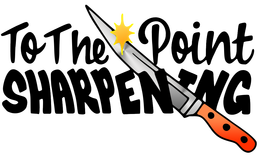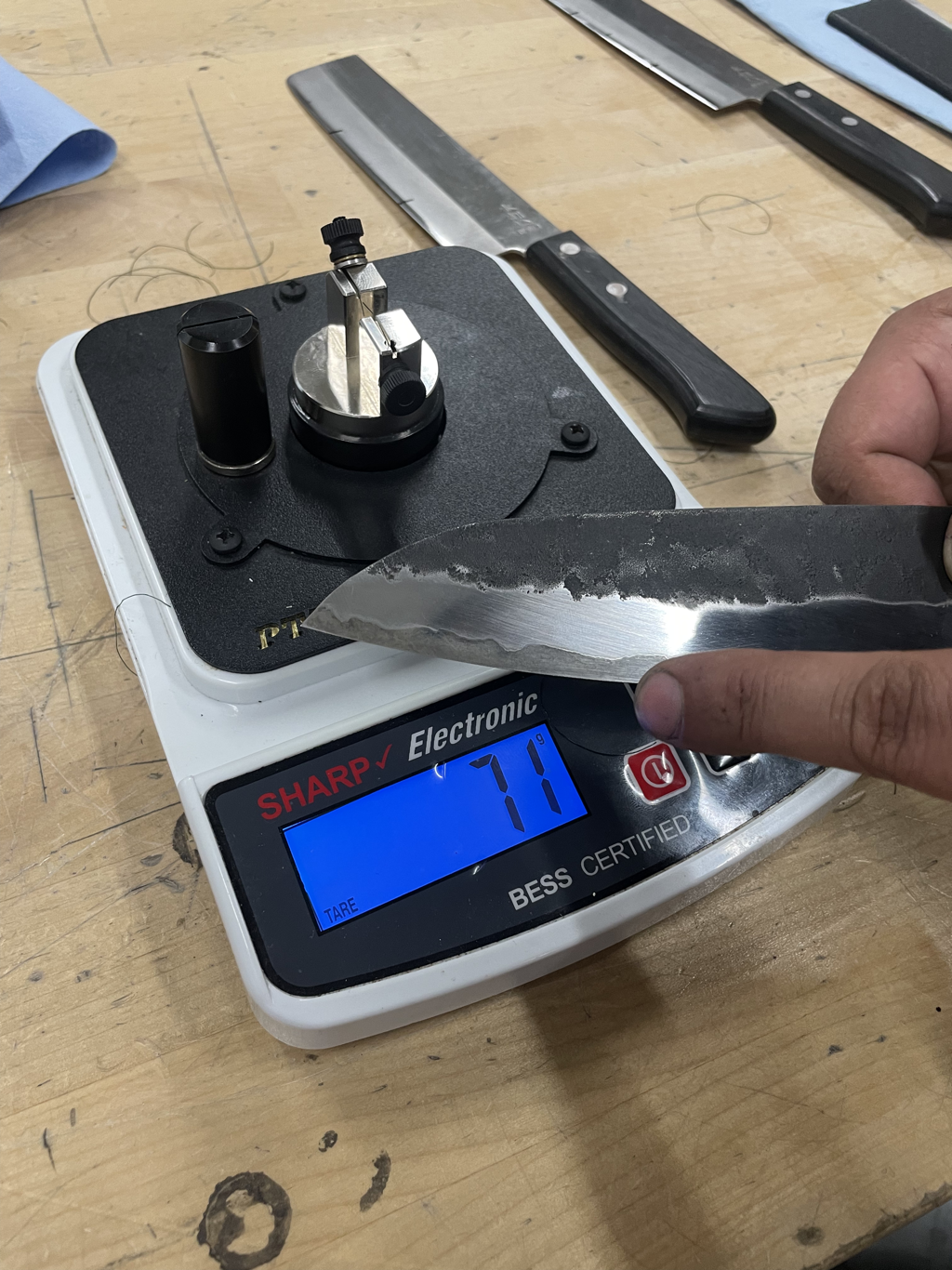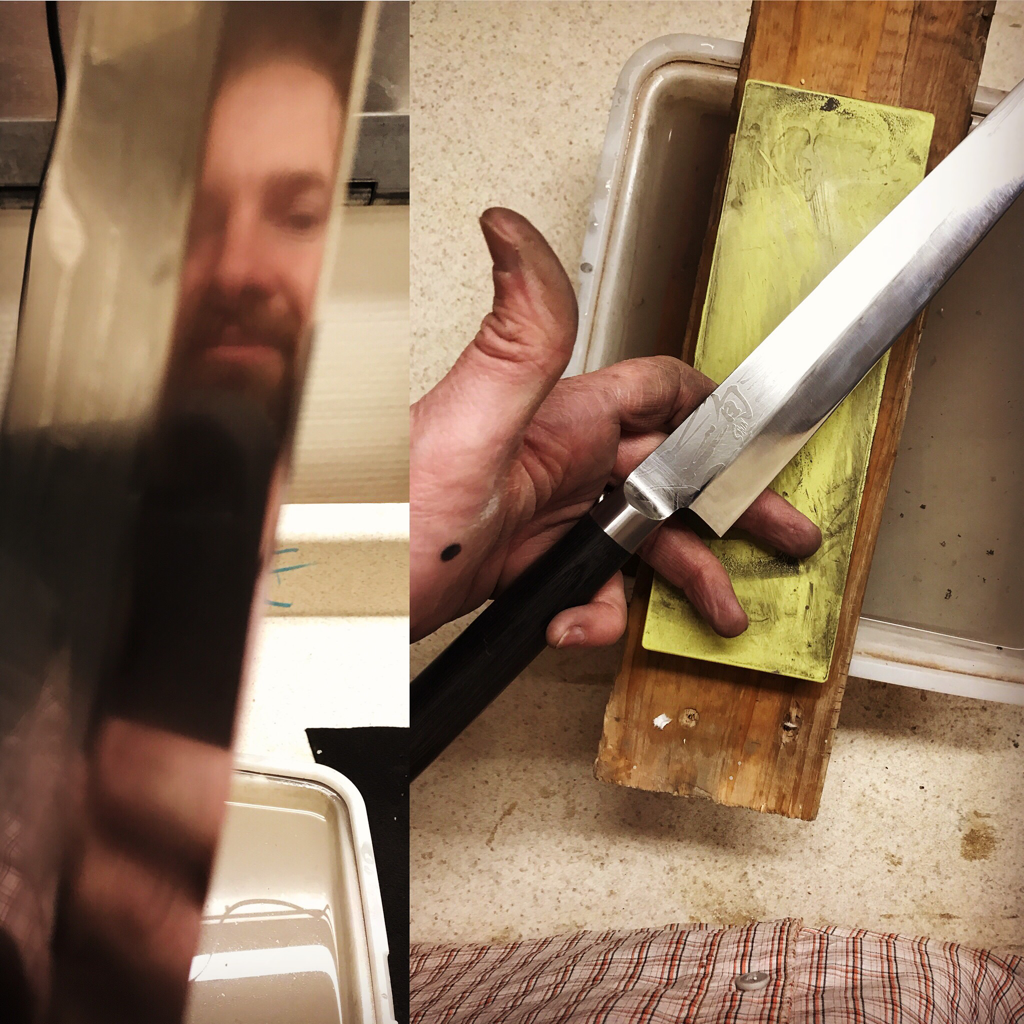Knife Care and Maintenance
To keep your knives in tip top shape:
- Proper storage is required to keep them from getting beat up. Keep your knives in a knife block, a magnetic knife strip, or with an edge guard of some sort
- Only use them on cutting board surfaces, the softer the cutting surface the longer the edge will last
- Use a knife for what it was intended to do, knife blades really do make terrible screwdrivers
- Wash it, dry it, and put it away right after using it
- Sharpen your tools regularly to keep those cutting tasks easy
Things to avoid with knives:
- Putting them in dishwashers, it cracks the handles and can corrode the blade.
- Storing them loosely in drawers, the edges take a beating usually
- Leaving them in the sink or in the drying rack, it can be dangerous for you and the knife
- Use the honing rod only if you are certain you know how to do it, I’d be glad to give you a lesson
Frequently asked questions:
I'm already sharpening my knife with my sharpening steel aren't i?
A sharpening steel is a little bit of a misnomer. It is really used for maintenance of knife edges in between sharpening. The cutting edge of a knife is actually comprised of little microscopic teeth. A smooth metal steel restores the alignment of these teeth on the edge, and can be used lightly from time to time. Technique is key to properly using a steel and should generally follow the angle at which the knife was sharpened.
Steels come in a variety of grits from rough to smooth, including diamond, steel, and ceramic steels. I recommend getting a ceramic steel or smooth metal steel if you use one at all. A lot of people do more harm with their steel than good. The most common ones are heavily textured and rough grit steels which act as a type of file on your knife edge. These steels can take the original knife edge and grind it off without the proper form and expertise. Ceramic steels take a small amount of metal off the edge, but not too much, creating a micro bevel on the edge. After a dozen or so times using a steel of any type it is usually time to resharpen. If you aren't versed in it's use it might just take one time to blunt your edge so be careful. I'd be happy to show you how to properly use a steel to make the most of it.
Steels come in a variety of grits from rough to smooth, including diamond, steel, and ceramic steels. I recommend getting a ceramic steel or smooth metal steel if you use one at all. A lot of people do more harm with their steel than good. The most common ones are heavily textured and rough grit steels which act as a type of file on your knife edge. These steels can take the original knife edge and grind it off without the proper form and expertise. Ceramic steels take a small amount of metal off the edge, but not too much, creating a micro bevel on the edge. After a dozen or so times using a steel of any type it is usually time to resharpen. If you aren't versed in it's use it might just take one time to blunt your edge so be careful. I'd be happy to show you how to properly use a steel to make the most of it.
how often should i get my knives sharpened?
This is dependent on how often you use your knives and how well you treat them. If you don't use them very often and take good care of them they can last several months to a year. If you are rough with your knives and use them a lot they may need it every week or two. Professionals in kitchens and butcher shops who constantly use their knives, and take care of them, usually use a sharpening service every two weeks to a month, but might sharpen on their own in between services. With normal household use, getting your knives sharpened every 3 months is the average frequency to keep your knives in top form.
what's the best way to store my knives?
Keeping them on a magnetic knife strip or a knife block are the most common safe methods. You might think twice about the magnetic knife strip if you have kids throwing stuff around in the house, but is generally safe otherwise. There are knife blocks that fit in kitchen drawers that I use to keep my countertops clear. A really cool new DIY option is to get a wood or plastic box with an open top, fill it with rice, and slide your knives right in. This works great as any size knife will slide right in making it very versatile with whatever knives you happen to have. The rice also wicks away moisture preventing corrosion.
What type of cutting board should i buy?
There are many types of cutting boards and some are better than others at keeping your knife sharp and creating cleaner cuts. The harder your cutting board surface is the faster it dulls your knives. The best type to keep your knives in top form are wood cutting boards. They are self healing from cuts and have antimicrobial properties, some species more than others. They need to be maintained by rubbing with food grade oils or butcher block conditioner from time to time to keep them from cracking or warping. That will happen if you put them in the dishwasher so be sure to always hand wash it.
The next best choice would be a plastic cutting board. These are great to have around to cut chicken and other meats on. Throwing these in the dishwasher will eliminate cross contamination that hand washing cannot always prevent. Plastic boards are good when new although once they get deep cuts in them or stains they start to harbor high levels of bacteria and need to be thrown out.
Bamboo is the next best choice as it is harder than plastic but still relatively easy on your blades. This is the most sustainable option because bamboo just grows so fast.
From here on out I can only list cutting boards and surfaces to steer clear of. Avoid cutting surfaces made of marble, ceramic, glass, granite, and steel. The minute you use one of these you'll blunt your knife's edge, although they can make great serving platters for cheese, cured meats, or vegetables. It pays to have multiple types of cutting boards for different purposes but if you have to get just one get a wood cutting board.
The next best choice would be a plastic cutting board. These are great to have around to cut chicken and other meats on. Throwing these in the dishwasher will eliminate cross contamination that hand washing cannot always prevent. Plastic boards are good when new although once they get deep cuts in them or stains they start to harbor high levels of bacteria and need to be thrown out.
Bamboo is the next best choice as it is harder than plastic but still relatively easy on your blades. This is the most sustainable option because bamboo just grows so fast.
From here on out I can only list cutting boards and surfaces to steer clear of. Avoid cutting surfaces made of marble, ceramic, glass, granite, and steel. The minute you use one of these you'll blunt your knife's edge, although they can make great serving platters for cheese, cured meats, or vegetables. It pays to have multiple types of cutting boards for different purposes but if you have to get just one get a wood cutting board.
I want to sharpen my own knives, what kind of sharpening stones should i get?
If you want to sharpen by hand the traditional way, Japanese waterstones are the way to go. It takes a good bit of practice to get good at it but is very rewarding once you get the hang of it. Japanese waterstones, both natural and synthetic, are known for their fast grinding qualities. Since they are lubricated with water they can be a lot less messier than oilstones and you don't have to buy oil to go with them. They work well for almost every knife.
Waterstones wear faster than oilstones but for a good reason. The small particles that do the cutting are bound together in the waterstone and during sharpening the surface particles are abraded and washed out, allowing new, sharper, particles to be revealed and to continue working on the blade. Oilstones tend to load up with metal particles as you sharpen, stopping the sharpening process, as the oil can make it harder for those metal particles to leave the stone. This can make sharpening very tedious and discouraging. You will always be making progress with a waterstone.
You'll need to get three stones to totally take care of your knives. The roughest grit stone should be a 220 or 400 grit stone which you use to grind out nicks and damage to the blade. The next stone to get is one that is in the range of 800 to a 1000 grit stone. This is the stone that really does the sharpening and if you stay on top your sharpening game you could just use this one almost exclusively. The final stone to round out a set needs to be in the range of 3000-6000 grit. This is your polishing stone that takes your edge to the next level and makes your edge last a bit longer. Getting your kitchen knife too polished can make your knife slide on tomato and pepper skins even though you have an exceptionally sharp knife. So any higher grit of sharpening stone is mostly for show.
Waterstones wear faster than oilstones but for a good reason. The small particles that do the cutting are bound together in the waterstone and during sharpening the surface particles are abraded and washed out, allowing new, sharper, particles to be revealed and to continue working on the blade. Oilstones tend to load up with metal particles as you sharpen, stopping the sharpening process, as the oil can make it harder for those metal particles to leave the stone. This can make sharpening very tedious and discouraging. You will always be making progress with a waterstone.
You'll need to get three stones to totally take care of your knives. The roughest grit stone should be a 220 or 400 grit stone which you use to grind out nicks and damage to the blade. The next stone to get is one that is in the range of 800 to a 1000 grit stone. This is the stone that really does the sharpening and if you stay on top your sharpening game you could just use this one almost exclusively. The final stone to round out a set needs to be in the range of 3000-6000 grit. This is your polishing stone that takes your edge to the next level and makes your edge last a bit longer. Getting your kitchen knife too polished can make your knife slide on tomato and pepper skins even though you have an exceptionally sharp knife. So any higher grit of sharpening stone is mostly for show.
Why can't I put my knife in the dishwasher?
Dishwashers are really rough on a knife. The heat, particularly with a drying cycle, will eventually crack the handle on your knife whether it is wood or synthetic. It will also get thrown around during the cycle which dings up the edge, can carve away at your dishwasher rack. The detergents really do knives no favors either and can erode away and etch all the parts of a knife eventually doing real damage.
CERAMIC KNIVES NEVER NEED SHARPENED DO THEY?
Any knife no matter what it is made of will eventually need sharpened. Since ceramic is harder than steel it takes it a long time to get dull but still does. These knives will need sharpened with diamond abrasives and can sometimes chip while sharpening. I recommend sending these knives back to the manufacturer to get sharpened because most all of them will do it for free, it just may take a little longer to get back.
what is THE BEST CHEF KNIfe?
This is a tough question because different knives are better choices for different people. There are different categories of knives that I recommend for people based off how they use their knife. If you are rough on your knives, like a lot of people are, you might do best with a German style knife. Those are usually stainless steel and over engineered to take some abuse. They aren't as likely to get damaged if you drop them and they usually have synthetic handles that won't crack like wood can. These knives aren't the sharpest though and can take more effort to use due to having thicker blades. They can also be tougher to sharpen due to a thick blade and the presence of a bolster. A bolster is that thick chunk of metal that runs perpendicular from the handle to the edge of the blade.
If you want a knife that is ultra sharp and don't mind a little maintenance get a Western style Japanese knife. A Western style Japanese chef's knife is known as a Gyuto. These knives are made of a harder blade steel for the sharpest edge. Some German style knife makers are catching on and adapting to this style. The blades on these knives are either a really sharp stainless steel type or carbon steel which can chip, discolor, or rust without proper care but is a bit sharper than stainless generally. They most always have wood handles which need an oil or wood conditioner rubbed on from time to time to prevent cracking. Western style Japanese knives have thinner blades which allow you to more easily maintain a better edge as it wears higher with sharpening but are more susceptible to damage. With proper care and maintenance these knives really are my favorite.
A good all around knife for beginners are Victorinox kitchen knives. This is a brand that is heavily used in commercial kitchens and is the standard in butcher shops. They really aren't the prettiest or best knife, but the handle has a good grip, they are inexpensive, a joy to sharpen, and have some good steel in the blade.
There are many knives that are great and it really is a personal choice as to what is the best. Look around and go to some knife shops and feel some handles to find what fits your hand. Look at the decoration and finish of the knife and decide what you are willing to pay for. An 8 inch or 20 centimeter chef knife is the standard size but you may feel more confident with a smaller size for better control. Buy what you feel is right for you and that is the best chef knife you could ever get.
If you want a knife that is ultra sharp and don't mind a little maintenance get a Western style Japanese knife. A Western style Japanese chef's knife is known as a Gyuto. These knives are made of a harder blade steel for the sharpest edge. Some German style knife makers are catching on and adapting to this style. The blades on these knives are either a really sharp stainless steel type or carbon steel which can chip, discolor, or rust without proper care but is a bit sharper than stainless generally. They most always have wood handles which need an oil or wood conditioner rubbed on from time to time to prevent cracking. Western style Japanese knives have thinner blades which allow you to more easily maintain a better edge as it wears higher with sharpening but are more susceptible to damage. With proper care and maintenance these knives really are my favorite.
A good all around knife for beginners are Victorinox kitchen knives. This is a brand that is heavily used in commercial kitchens and is the standard in butcher shops. They really aren't the prettiest or best knife, but the handle has a good grip, they are inexpensive, a joy to sharpen, and have some good steel in the blade.
There are many knives that are great and it really is a personal choice as to what is the best. Look around and go to some knife shops and feel some handles to find what fits your hand. Look at the decoration and finish of the knife and decide what you are willing to pay for. An 8 inch or 20 centimeter chef knife is the standard size but you may feel more confident with a smaller size for better control. Buy what you feel is right for you and that is the best chef knife you could ever get.



